You are hereProjects/ 4-channel UDDAS/ Dolphin acoustics - part 3
Projects/ 4-channel UDDAS/ Dolphin acoustics - part 3
PREVIOUS: Sound production and reception
INTRODUCTION TO DOLPHIN ACOUSTICS - part III
Three types of sounds
Besides echolocation clicks, dolphins also make other types of sounds. Most dolphin species produce three types of signals: echolocation clicks, burst pulse clicks, and whistles. Of these, burst pulse clicks and whistles are thought to be used mainly for communication. Click on each of the sound files below to hear an example of how they sound.
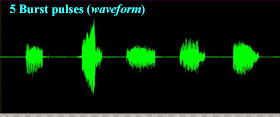
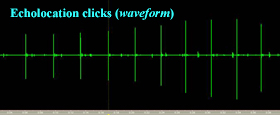
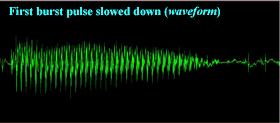
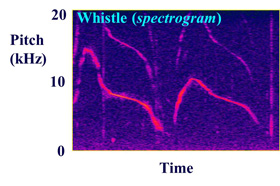 Burst pulse clicks are very similar to echolocation clicks, except for their pace. Echolocation clicks have intervals ranging from 20 up to several hundred milliseconds, that allow for the sound to travel to the target of investigation and then back to the dolphin, plus some additional processing time before the dolphin emits the next click. Burst pulse clicks on the other hand have very short intervals of only 0.5 to 10 ms, which means that 100 to 2,000 of these burst pulse clicks would fit into one second. Since this is way too fast for our hearing to distinguish the individual clicks, they sound to us somewhat like squeaking doors.
Burst pulse clicks are very similar to echolocation clicks, except for their pace. Echolocation clicks have intervals ranging from 20 up to several hundred milliseconds, that allow for the sound to travel to the target of investigation and then back to the dolphin, plus some additional processing time before the dolphin emits the next click. Burst pulse clicks on the other hand have very short intervals of only 0.5 to 10 ms, which means that 100 to 2,000 of these burst pulse clicks would fit into one second. Since this is way too fast for our hearing to distinguish the individual clicks, they sound to us somewhat like squeaking doors.
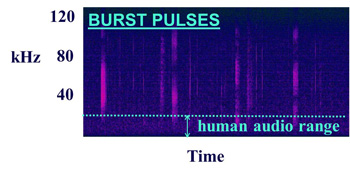 Both echolocation and burst pulse clicks themselves are extremely short pulses of sound (only 50 microseconds, or 1/20,000th of a second long) and are broadband high frequency signals, containing pretty much all frequencies from 0 to over 200 kiloHertz (i.e. more than 200,000 vibrations per second). Since our hearing extends to only 12-20 kHz, we can hear only the very low portion of these clicks (that’s why these sounds are called ultrasonic, i.e. higher than what humans can hear). And quite a few clicks have no energy at all below 20 kHz and would be missed by us completely.
Both echolocation and burst pulse clicks themselves are extremely short pulses of sound (only 50 microseconds, or 1/20,000th of a second long) and are broadband high frequency signals, containing pretty much all frequencies from 0 to over 200 kiloHertz (i.e. more than 200,000 vibrations per second). Since our hearing extends to only 12-20 kHz, we can hear only the very low portion of these clicks (that’s why these sounds are called ultrasonic, i.e. higher than what humans can hear). And quite a few clicks have no energy at all below 20 kHz and would be missed by us completely.
 Whistles on the other hand are frequency modulated single tones and are generally within the human hearing range (i.e. below 20 kHz), but also have ultrasonic components called harmonics (or “overtones”) which can go up to more than 100 kHz. Dolphins have been found to produce whistles that are unique to individuals (so-called signature whistles), which are used e.g. for mother-calf bonding. Also maintaining group cohesion in swimming formations is thought to be an important function of whistles.
Whistles on the other hand are frequency modulated single tones and are generally within the human hearing range (i.e. below 20 kHz), but also have ultrasonic components called harmonics (or “overtones”) which can go up to more than 100 kHz. Dolphins have been found to produce whistles that are unique to individuals (so-called signature whistles), which are used e.g. for mother-calf bonding. Also maintaining group cohesion in swimming formations is thought to be an important function of whistles.